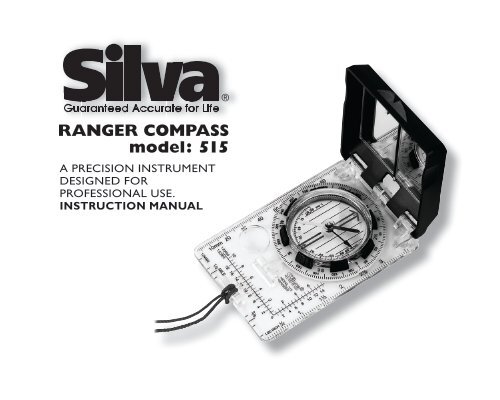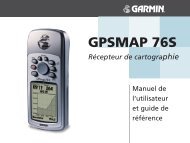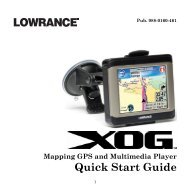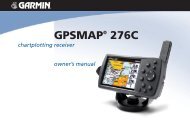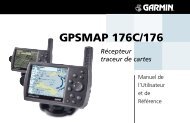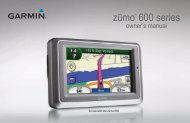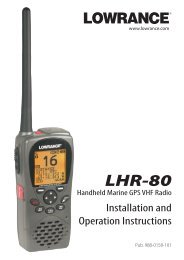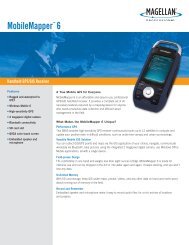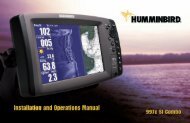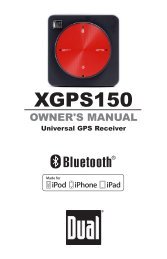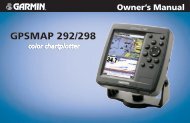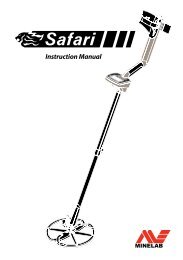Compass Instructions
Compass Instructions
Compass Instructions
Create successful ePaper yourself
Turn your PDF publications into a flip-book with our unique Google optimized e-Paper software.
RANGER COMPASS<br />
model: 515<br />
A PRECISION INSTRUMENT<br />
DESIGNED FOR<br />
PROFESSIONAL USE.<br />
INSTRUCTION MANUAL
2<br />
Your Silva Ranger <strong>Compass</strong> is a precision instrument made by experienced<br />
specialists in this field; it is the finest hand compass available for professional<br />
use. Your Silva Ranger is finely crafted to withstand rigors associated with the outdoor<br />
professions. It is a rugged, durable piece of equipment that, with proper care,<br />
will remain dependable and accurate.<br />
We recommend that you read this manual to understand the basic functions of<br />
the compass. When you read, keep in mind that no two compass applications are<br />
identical. The instructions given here are intended to provide you with a working<br />
knowledge that you will be able to apply in almost any situation.<br />
The illustrated 360 Degree Graduations are based on standard dial graduations<br />
of 360 degrees, in 2º increments. With this graduation North is 0º and increases<br />
clockwise so East is 90º, South is 180º, West is 270º and 360º is again North. 0º<br />
and 360º are the same direction.<br />
T he Silva Ranger Model 515CLQ has Quadrant Graduations. With this graduation<br />
North is 0º and increases clockwise so East is 90º then it decreases so South is 0º<br />
then increases so West is 90º and then decreases so North is 0º. <strong>Instructions</strong> in<br />
this manual will apply to this graduation except when it is necessary to refer to the<br />
proper “quadrant,” such as North 20º East, or North 15º West, or South 40º East<br />
or South l0º West.
compass cover<br />
luminous points<br />
base plate<br />
black clinometer<br />
pointer<br />
magnetic needle with<br />
red north<br />
2X magnifier<br />
scale in mm<br />
sight<br />
mirror<br />
sighting line<br />
index pointer<br />
orienting arrow with red<br />
north end<br />
meridian lines<br />
liquid filled capsule<br />
bezel with<br />
2º graduations<br />
scale in inches<br />
3
General Suggestions<br />
Y<br />
A<br />
A<br />
T<br />
P<br />
our Silva Ranger compass may be used for finding directions with or without the<br />
aid of the sighting mirror. LEARN BOTH WAYS.<br />
1. When extreme accuracy required: With the sighting mirror, hold compass at eye<br />
level with cover opened to an acute angle.<br />
2. When quick accuracy required: With the sighting line as a direction pointer, hold<br />
the compass at waist level with cover wide open. In either instance, the compass<br />
must be held level enough to permit the needle to swing freely.<br />
lways check compass function prior to using it in the field. Be aware that exposing<br />
your compass to articles with iron content (a magnetic field) can cause the<br />
red end of the needle to align with South, a condition called reverse polarity.<br />
Something as simple as being placed next to a pair of scissors or knife for a length<br />
of time, microwaves, high tension wires, stereo speakers, magnets, etc. can cause<br />
this problem.<br />
small bubble may form in the liquid compass, but it has no influence on accuracy.<br />
The appearance and disappearance of this bubble is due to changes in temperature<br />
and atmospheric pressure. Bubbles larger than 1/4" diameter, however, should be<br />
viewed with suspicion and probably are caused by a leaking capsule.<br />
o increase their brilliance, expose the luminous points to bright light before use.<br />
rotect your compass from high temperatures extremes. The heat expanded liquid<br />
could damage the capsule.<br />
4
The Clinometer<br />
T<br />
he SILVA Ranger compasses are practical instruments for measuring angles of<br />
inclination. The long side of the compass coincides with the slope of the terrain.<br />
Measure an angle of inclination in the following way:<br />
1. Open the lid completely.<br />
2. Turn the dial so that the cardinal point “W” on the dial is set at the index pointer.<br />
3. Hold he compass at eye level with arms out-stretched so that the clinometer<br />
needle is hanging vertically and follows the scale in the bottom of the compass<br />
housing. “S” on the compass should point down.<br />
4. Let one long side of the compass coincide with the slope of the terrain— the<br />
inclination you wish to measure.<br />
5. Read the angle of inclination at the point of the clinometer needle.<br />
Rules of Use<br />
T<br />
E<br />
T<br />
wo separate sets of rules apply to the use of a magnetic compass. One set applies<br />
if you work “from map to terrain.” In this case you take “map bearings.” In the following,<br />
Sections A, B, C, D and E deal with “from map to terrain.”<br />
xactly opposite rules apply if you work “from terrain to map.” In this case you use<br />
“field bearings,” also called “magnetic bearings” and “compass bearings,” Sections F,<br />
G and H deal with “from terrain to map.”<br />
he word “map” is broadly interpreted to also include charts, descriptions and even<br />
a mental picture of the terrain.<br />
5
6<br />
basic conditions to determine field directions<br />
Section A<br />
To use the compass to indicate directions in the field, two basic conditions must<br />
always be accomplished. These are:<br />
1. The dial must be set to the desired degree reading. If the degree or direction is<br />
known, turn the dial to the correct reading at the index pointer. If the degree is<br />
unknown, then it should be obtained from a suitable map.<br />
2. Without changing the dial setting, the entire compass must be positioned so that<br />
the orienting arrow lines up with the magnetic needle and the red end of needle<br />
lies between the two orienting points.<br />
W<br />
hen both conditions are fulfilled, the desired direction is indicated by the sighting<br />
line or by the sight.<br />
determine directions without the sight<br />
Section B<br />
To fulfill the two conditions described in Sect. A:<br />
Set dial according to Sect. A (1)<br />
• With the dial set, open the cover wide and hold it waist high in front of you.<br />
The sight and sighting line should be pointing ahead of you not back toward<br />
your body. The sighting line now acts as a pointer.<br />
• Turn yourself and compass together until the orienting arrow is lined up with<br />
the magnetic needle. This accomplishes Sect. A (2) and the sighting line now<br />
will be pointing the correct direction.
• While still holding the compass, imagine a line extending exactly straight out from<br />
the sighting line. Your objective lies along that imaginary line.<br />
determine directions with a sight<br />
Section C<br />
To fulfill the two conditions described in Sect. A:<br />
Set the dial according to Sect. A (1).<br />
• Hold the compass at eye level and adjust the cover to a 50º—70º opening. The<br />
mirror should reflect a top view of the compass dial.<br />
• While looking in the mirror, move your sighting eye sideways until you see the<br />
sighting line intersect one of the two luminous points.<br />
• Without changing the relationship between compass and eye, pivot yourself and<br />
compass together until you see, in the mirror, that the orienting arrow is lined<br />
up with the magnetic needle and the red end of needle is between the orienting<br />
points. This accomplishes Sect. A (2). Your direction or objective will now lie<br />
straight beyond the sight.<br />
NOTE: Be sure to keep the base plate level so magnetic needle can turn freely. When<br />
sighting uphill or downhill, lower the sighting eye in relation to the compass.<br />
NOTE: A greater than 70º cover opening will increase the parallax effect and could<br />
cause as much as a 5º reading error.<br />
7
8<br />
Obtain a bearing from a map<br />
Section D<br />
W<br />
R<br />
e state in Sect. A, that one of the two conditions for using the Silva Ranger is to<br />
set the dial at the desired degree reading. If this degree or bearing is not known, it<br />
can be determined from a map. Your compass is also a protractor with a transparent<br />
bottom in the dial housing. Two steps are required:<br />
1. Lay the compass on the map so either the inch scale or the millimeter scale<br />
is exactly on (or parallel with) the line on the map you wish to travel, and the<br />
hinged cover points in the direction of travel.<br />
2. Hold the compass in position on the map, turn the dial so the meridian lines of<br />
the compass are exactly parallel with any meridian (North-South) line on the<br />
map, and the letter “N” on top of the dial is toward North on the map.<br />
emove the compass from the map. These two steps set your compass for the<br />
degree reading to your destination. This reading may be read at the index pointer.<br />
You fulfilled the first basic condition in Sect. A. Proceed to Sect. B or C.<br />
About declination<br />
Section E<br />
T<br />
he magnetic needle in a compass is attracted by the magnetism of the Earth. This is<br />
why it always points to the constantly shifting Magnetic North where the magnetic<br />
lines of force come together. There is another “North Pole.” True North is static<br />
and located geographically, maps and directions usually are based on True North.
declination map<br />
for North America<br />
9
10<br />
Magnetic declination is the angle between True North and Magnetic North. The<br />
amount of declination at any given point depends on the location of that point on<br />
the continent. Where True and Magnetic North are in the same direction, the declination<br />
is zero. In North America a line of zero declination runs roughly from west<br />
of Hudson Bay down along Lake Michigan to the Gulf Coast in western Florida.<br />
At any point west of that line, your compass needle will point east of True North.<br />
This is called “Easterly Declination.” At any point east of that zero line, your compass<br />
needle will point west of True North. This is called “Westerly Declination.” In<br />
North America, magnetic declination varies from 30º east in Alaska to 30º west in<br />
Labrador. See diagram on page 9.<br />
Allow for Declination<br />
W<br />
here accuracy is not critical, ignore magnetic declination, especially in areas where<br />
the declination is minor. You may also ignore it when the compass is used without<br />
reference to maps and is based on field bearings only.<br />
hen the compass is used with a map or in connection with map bearings, adjustment<br />
should be made. There are two methods to accomplish this:<br />
1. Temporary Method. You must redo every time you wish to apply it.<br />
Find the amount of declination in their area and whether it is easterly or westerly.<br />
This information is on topographic maps of the area.<br />
Take your bearing from the map as described in Sect. D. and observe the degree<br />
reading at the index pointer.<br />
W
Turn the dial to increase or decrease that reading according to the declination.<br />
Easterly, decrease the dial reading and westerly, increase the reading.<br />
For example, if your bearing from the map is l00º and the declination is 10º East,<br />
DECREASE the reading 10º by turning the dial to 90º. If the declination is 10º<br />
West, INCREASE the reading of l00º to read 110º.<br />
2. Permanent Method. Your compass is equipped with an offsetting mechanism to<br />
allow for declination. If you use the compass extensively in one locality, once set,<br />
you need not make further allowances. The adjustment simultaneously takes care<br />
of both map bearings and field bearings.<br />
The offsetting mechanism consists of two bottoms in the compass dial housing,<br />
one of which can be offset in relation to the other by means of a declination<br />
adjusting screw located on the underside of the base plate. The orienting lines<br />
and the declination scale are engraved on one bottom. The orienting arrow<br />
and the orienting points are on the other. As you turn the adjusting screw you<br />
change the angle between the orienting lines and the orienting arrow. It is this<br />
angle that should correspond to the declination of your area. A screwdriver, provided<br />
for this purpose, is tied onto the lanyard.<br />
For example, if the declination in your area is 10º west, turn the adjusting screw<br />
so that the orienting arrow points to 10º on the “west” side of the declination<br />
scale. If your declination is 10º east, adjust the orienting arrow to 10º on the<br />
“east” side of the declination scale. Use the black index line of the orienting<br />
arrow to make an accurate setting.<br />
11
12<br />
NOTE: The declination offsetting mechanism is set at zero at the factory. Use the<br />
zero setting for all compass operations which involve no allowance for declination<br />
or in which the temporary allowance is being used. If the declination scale does<br />
not read zero, set it to zero with the adjusting screw.<br />
NOTE: When the orienting arrow is not set at zero, it becomes obvious that the<br />
orienting lines and the orienting arrow serve different purposes. The orienting lines<br />
are used to line up with orienting lines on the map. The orienting arrow is used to<br />
line up with the magnetic needle when using compass in the field.<br />
take a bearing<br />
Section F<br />
A<br />
“bearing” is the direction or the degree reading from one object to another. One<br />
of those objects is usually YOU. To “take” a bearing means to DETERMINE the<br />
direction from one object to another.<br />
1. Bearings are taken from a map as in Sect. D. The “bearing” is the degree reading<br />
indicated at the index pointer.<br />
2. Bearings can be taken on the terrain, by reversing the steps in Sect. B and C.<br />
When using the compass without the sight, open the cover wide and hold it<br />
level, at waist high, in front of you. The sight and sighting line should be pointing<br />
straight ahead of you. The sighting line acts as a pointer. Pivot yourself and compass<br />
together until the sighting line points straight to the object on which you<br />
are taking the bearing. Without changing position of the compass, carefully turn<br />
the dial until the orienting arrow and the magnetic needle are lined up and with
the red end of needle lying between the two orienting points. The “bearing” to<br />
your object is now the degree reading indicated at the index pointer.<br />
3. Bearings can be taken by using the sight. Hold the compass at eye level and<br />
adjust cover so top of the dial is seen in mirror. Face toward your object and<br />
sight object across compass sight. Look in the mirror and adjust position of<br />
compass so that the sighting line intersects one of the luminous points. While<br />
you simultaneously see your object across the sight, and the sighting line across<br />
one of the luminous points, turn the dial so that the orienting arrow is lined up<br />
with the needle, red end between the orienting points. The “bearing” to your<br />
object is now the degree reading indicated at the index pointer.<br />
Adjust field bearings for declination<br />
Section G<br />
1. The permanent adjustment for declination eliminates need for further adjustment.<br />
2. To accomplish the temporary adjustment for field bearing declination: Take a<br />
bearing as described in Sect. F and observe the degree reading at the index<br />
pointer. Turn the dial to increase or decrease that reading according to the declination.<br />
If declination of your area is easterly, increase your dial reading by the<br />
amount of declination. If westerly, decrease the reading.<br />
For example, assume your field bearing is 100º. If the declination is 10º east,<br />
INCREASE the reading 10º by turning the dial to read 110º. If the declination is<br />
10º west, DECREASE the reading of 100º to read 90º.<br />
13
NOTE: The instructions for a “temporary” adjustment for declination of a field bearing<br />
are exactly opposite from the temporary adjustment of a map bearing.<br />
NOTE: The declination scale should be set at zero for all compass operations which<br />
involve no allowance for declination; or when the temporary method is used.<br />
A “Short-Cut” Method to Deal with Declination:<br />
When the compass is used with a map, no adjustment is necessary if the orienting<br />
lines on the map are drawn according to Magnetic North instead of True North.<br />
Most topographic maps are drawn according to True North and the orienting lines<br />
are also according to True North.<br />
Draw your own orienting line according to Magnetic North:<br />
On all topographic maps, there is a declination diagram near the bottom. The star line<br />
designates True North and is parallel with the orienting lines. However, the single<br />
barb arrow designates Magnetic North. Draw your own Magnetic North orienting<br />
lines by drawing 1" or 2" lines across the map that are parallel to the Magnetic<br />
North arrow. Use these lines instead of the True North lines when setting your<br />
compass and you will not need to adjust for declination.<br />
Plot Locations on a Map<br />
Section I<br />
Triangulation method:<br />
Find two specific sites (a) and (b) on the map which you recognize, by sight, on the<br />
terrain. These are the chosen points from which to take cross bearings.<br />
14
Adjust your compass for the declination of your area by the permanent method.<br />
Take a bearing to the first site (a)— without disturbing the dial setting.<br />
Place the compass on the map so that either side of the base plate intersects the<br />
symbol for the chosen site (a). Keep the edge of compass base plate on the symbol<br />
and turn entire compass on the map until the compass orienting lines in the bottom<br />
of the dial are parallel with the orienting lines on the map, and so that the<br />
orienting arrow points upward on the map (North).<br />
NOTE: Orienting arrow may be slightly off of North because of declination adjustment.<br />
Draw a line on the map along the edge of the compass, intersecting the symbol. You<br />
are somewhere along this line. To establish your position along this line, you need<br />
another bearing.<br />
Take a bearing to the second site (b) and mark a line as you did with site (a). This line<br />
will intersect the first line. Where the lines cross is your exact position.<br />
BE EXPERT WITH MAP AND COMPASS, Second Edition<br />
Björn Kjellström<br />
This new and enlarged edition includes everything you need to know about the<br />
skill of Orienteering; how to use a map and compass, alone or together. The text<br />
includes a series of games and exercises which encourage self-training. Each copy<br />
of the book also contains a sample training map to help you put newfound knowledge<br />
into practice. Required reading for the beginner in map and compass work. 15
Johnson Outdoors Gear LLC<br />
625 Conklin Road<br />
Binghamton, NY 13903<br />
www.silvausa.com<br />
Johnson Outdoors Inc. Canada<br />
4180 Harvester Road<br />
Burlington, Ontario Canada L7L 6B6<br />
1.905.634.0023 Fax 1.800.661.1170<br />
16Johnson Outdoors Gear LLC. © 2009 p/n 5793150C 2-09


